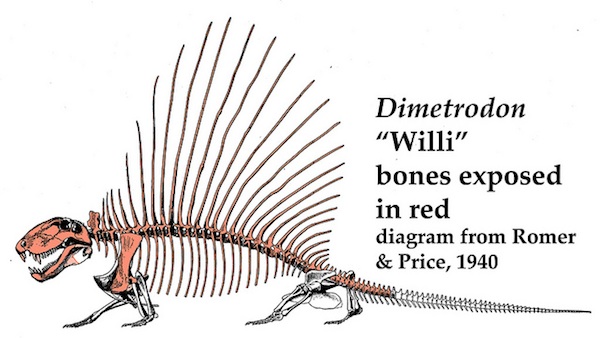Ancient Tiger-Sized Predator Unearthed in Texas

Paleontologists have unearthed a nearly complete fossil of a dimetrodon, a reptile-like predator that roamed the Permian landscape 287 million years ago.
This weekend, the team is working to transport the 400-pound animal's torso from its resting place in north Texas to Houston, where the fossil will be prepped for display in the newly renovated Houston Museum of Natural Science (HMNS) paleontology hall in 2012.
Famous for the enormous fin on its back, dimetrodon is often mistaken for a dinosaur, although dimetrodons pre-dated dinos by millions of years. The creature could easily pass as a reptile, but dimetrodon wasn't precisely reptilian, either: It was a synapsid, a category that includes modern mammals. Think of dimetrodon as a very distant, very toothy cousin.
The first dimetrodon fossils were discovered in the late 1800s, but the new find is the most complete skeleton of the species found in 100 years, said Robert Bakker, HMNS curator of paleontology and the director of the dig that uncovered the fossil.
"It's stunning," Bakker told LiveScience. "Everyone who visits it, and there's been a steady stream of ranchers and amateur paleontologists, they just sit at the edge of the quarry and stare in reverence."
The dimetrodon, dubbed "Wet Willi" by the researchers after Samuel Williston, a paleontologist who dug at the site 100 years ago, was found in north-central Texas in the remains of an ancient sinkhole. The site has been a rich source of dimetrodon bones for decades, but the Houston team began the first meticulous exploration of the area five years ago. Since then, the researchers have turned up a number of partial dimetrodon fossils as well as the bones of smaller reptiles and amphibians.
"This site has more dimetrodon bones in it than the rest of the world put together," Bakker said.
Sign up for the Live Science daily newsletter now
Get the world’s most fascinating discoveries delivered straight to your inbox.
Wet Wilii
But until this year, the researchers and their teams of volunteers hadn't turned up anything as complete as Willi. The fossil was first discovered on a steamy day in June. David Temple, the associate curator of paleontology at the Houston museum, was digging a drainage ditch in the fossil site when he came across the dimetrodon's jaw, full of steak-knife teeth.
At first, the team didn't realize how intact the find was. Then a volunteer, children's book author Kathleen Zoehfeld, uncovered the thin bones that once held up the animal's sail.
"You're constantly waiting for the bone to end and then that's all there is, and you've got a fragment or something like that," Temple told LiveScience. "But in this particular case, you know, we got the whole thing."
On display
The new Willi specimen may help clear up questions about how many dimetrodon species there were, Bakker said. But Willi will also be a tool for education.
"Willi will be the subject of much scientific analysis, but the real goal is to have natural objects that make kids' brains shift from 1st gear to 2nd gear to 3rd gear to 4th gear," Bakker said.
Willi is already making an impression on the public, Bakker said. The owner of the ranch where Willi was found has visited the fossil a half-dozen times, as have the cattlemen who run cattle on the property, Bakker said. One local cattleman had his own take on the discovery.
"He said, 'The only thing prettier is a newborn calf,'" Bakker said.
You can follow LiveScience Senior Writer Stephanie Pappas on Twitter @sipappas.

Stephanie Pappas is a contributing writer for Live Science, covering topics ranging from geoscience to archaeology to the human brain and behavior. She was previously a senior writer for Live Science but is now a freelancer based in Denver, Colorado, and regularly contributes to Scientific American and The Monitor, the monthly magazine of the American Psychological Association. Stephanie received a bachelor's degree in psychology from the University of South Carolina and a graduate certificate in science communication from the University of California, Santa Cruz.










